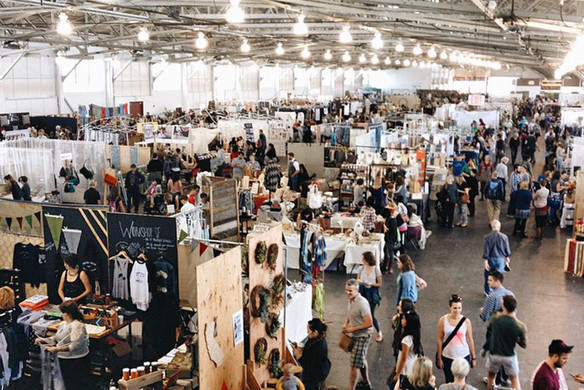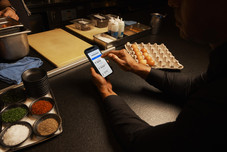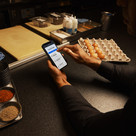If you sell anything from letterpress cards to artisan jams, the Renegade Craft Fair circuit is a great way to get your name out there. What’s more, buyers from stores like Anthropologie and The Land of Nod are often amongst the crowd — scouting for unique stuff to bring into stores.
But it’s competitive to get in. Each year, the judges at the Renegade Craft Fair receive thousands of applicants and only admit a few hundred per show. So how do you stand out? We spoke with one of the curators, Madelon Juliano, to get her top tips.
Square: Do you recommend getting your application in early?
Juliano: In a way, yes. While getting your application in early doesn’t technically help your chances of getting in the show, the jurors go through a ton of work. Our craft world can be a very saturated one, and once you get to the end of hundreds of applications, the more popular categories (such as jewelry, for example), start to look suspiciously alike. That said, if I see a unique, well-designed/presented application from a jeweler at the very end of the jurying process, it’s likely that they’ll still get in the show.
What are the most common mistakes people make in the application process?
Even if your work/website is super put together, you need to be on top of the application process. Adhere to the deadlines, and get in touch with questions if you have them. We have two lovely vendor coordinators (who are also jurors) that you can contact if you have any questions.
Other than not being on top of things, what other mistakes do you see?
I don’t recommend linking to your Facebook page in your application. We’re looking for makers who have a gallery of their work, presented on a platform that’s easily navigable, up to date, and well photographed. Steer clear of stuff like music intros or pop-up windows — or just an overly busy site (I personally think this helps with sales as well).
If you don’t have the budget or time for a website, then setting up a Tumblr page, or even an Instagram of images, is a great start.
Should you hire a professional photographer to shoot your stuff?
Most of us have friends or family with a nice camera. It doesn’t have to be an expensive process. Maybe do a trade with them to take pictures of your work.
As far as styling goes, put your work in an appropriate environment. If you’re a jeweler, show your work on a body as well as on a white background. If you’re an artisanal food vendor, give the consumer (and us) an idea of your packaging and overall aesthetic. Consider what type of environment you envision your products living in. If you or someone you know has a great apartment, shoot there.
So images are key. But should there be any text on the website?
Text can be very helpful. While jurying, it’s nice to be able to scroll over to the “about” sections of makers’ websites to learn more about their processes.
Another thing to keep in mind is that we’re always looking for outstanding makers to feature on our blog/social media platforms; it’s usually during the application/jurying process that we decide on who to feature.
Do you set a limit in certain categories on the number of products you accept?
We don’t have a print or jeweler limit or anything like that. If something’s wonderful and stands out from the rest, it’s likely to make it in. That said, plagiarism is a common problem. It’s one thing to play on a popular trend, but it’s a whole different rodeo when you see makers straight up copying each other. Push forward and make something unique.
So if you’re a returning merchant, how do you show that your work has progressed?
That’s becoming less and less of a problem. The craft community is much more competitive now, and makers realize that to stay in the game, they have to keep things fresh. Part of our role in the community is helping artists grow.
Makers participating or attending our events are surrounded by the best of the best in our community — it’s inspirational. They push each other and we push them to grow. It’s a very collaborative, symbiotic relationship.
It used to be birds, then it was owls. What do you think the hot animal will be this year?
I’ve been seeing a ton of cool, graphic fish on prints, clothing, notebooks, etc. Nic Annette Miller (a Brooklyn-based artist) made her entire booth look like a fish market — using wood fish she carved herself. It was one of the coolest booths I’ve seen.
Speaking of booths — any best practices there?
Always pay attention to what type of booth you’re applying for, and the show venue, whether it’s indoors, outdoors, etc. Mobile booths seem to be the most confusing for makers applying. A mobile booth means you move around the venue, sort of like a popcorn guy at a baseball game.
Do you have any examples of standout booths?
Yes! We have a whole album dedicated to them on our Pinterest page. It’s updated after each show.
What about food and drink sellers? What do you look for there?
We look for artisanal foods, but we also pay close attention to the packaging and styling. Even if you make the most delicious chocolates in the world, if they’re more traditional (e.g., heart shapes, in gold foil), that’s not what we’re all about. The packaging should be just as unique as the flavors.
What if you’d like to do a workshop? How do you stand out there?
We actually need more workshops. It’s such a great way to promote your business — and you can differentiate yourself by doing it. We tend to put people doing workshops in visible, more trafficked locations.
What sort of trends are you most excited for?
I’m really interested in artists who are creating grouped or collaborative lines — things like clothing, bags, jewelry — that all work together. I think artists are exploring a lot more and expanding their repertoire, which is really exciting. A jewelry maker will take a weaving class, or make a mobile, and all of a sudden they have another exciting business on their hands.
For advice on Renegade Craft Fair’s application process, be sure to check out their guides, which offer a wealth of information.
Headed to a Renegade Craft Fair this year? Be sure to let your customers know via Square’s email marketing tools.
![]()











